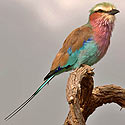|
Family: Coraciidae (rollers)
Life
> Eukaryotes >
Opisthokonta
> Metazoa (animals) >
Bilateria >
Deuterostomia > Chordata >
Craniata > Vertebrata (vertebrates) > Gnathostomata (jawed
vertebrates) > Teleostomi (teleost fish) > Osteichthyes (bony fish) > Class:
Sarcopterygii (lobe-finned
fish) > Stegocephalia (terrestrial
vertebrates) > Tetrapoda
(four-legged vertebrates) > Reptiliomorpha > Amniota >
Reptilia (reptiles) >
Romeriida > Diapsida > Archosauromorpha > Archosauria >
Dinosauria
(dinosaurs) > Saurischia > Theropoda (bipedal predatory dinosaurs) >
Coelurosauria > Maniraptora > Aves
(birds) > Order: Coraciiformes
Species indigenous to southern Africa
|
Coracias caudatus
(Lilac-breasted roller) The Lilac-breasted roller
is found from Eritrea and Somalia south to the northern half of southern
Africa, where it is common in dry woodland. It feeds on a wide variety of
animals, preferring insects over reptiles, arachnids, birds and rodents. It
usually uses cavities in trees as nest sites, 2-8 m above ground, although
it is capable of kicking other birds out of their nests. It lays 2-4 eggs,
which are incubated by both sexes, for 17-25 days. The chicks stay in the
nest for about 19 days, after which it is dependent on its parents for about
20 more days. |
 |
|
Coracias garrulus
(European roller) The European roller a
non-breeding visitor, with breeding grounds in Morocco, Spain, Poland,
Siberia and India, with its non-breeding range entirely in sub-Saharan
Africa. In southern Africa, it has a scattered distribution range,
preferring savanna, such as broad-leaved and Acacia woodland. It eats
mainly flying insects, such as termite alates, beetles, and locusts, rarely
eating small vertebrates. It hunts from perches, waiting until prey gets
close, before pouncing on it. |
 |
|
Coracias naevius
(Purple roller) The Purple roller is endemic to Africa, being found from
Senegal and Gambia to Somalia, extending south to southern Africa. It is
widespread but uncommon, living in dry woodland and savanna. It feeds not
only on insects but also scorpions, small reptiles, mice and even young
birds. Courtship is elaborate, with courtship feeding and acrobatic flight
displays commonly recorded. It lays 3-5 eggs, usually a cavity in a
(frequently dead) tree, at least 5 m above ground. It also uses rock
crevices and vertical pipes. |
 |
|
Coracias
spatulatus (Racket-tailed roller) The
Racket-tailed roller is endemic to Africa, occupying an area from Tanzania
to Angola, south to Zimbabwe Botswana and Mozambique. It prefers mature
undisturbed deciduous woodland, especially Miombo, Mopane and Zambezi Teak
woodland. Its diet is little known, but it is thought to feed mainly on
insects, hunting from low perches, swooping to catch prey once spotted. It
is probably a cooperative breeder, nesting in tree cavities about 6-7 m
above ground, either natural or excavated by large woodpeckers. There is
little more information about its breeding habits, as there have been no large
studies done on this species. |
 |
|
Eurystomus
glaucurus (Broad-billed roller) The
Broad-billed roller is found from Senegal east to Somalia, extending south
to Zimbabwe, Mozambique, Botswana and north-eastern South Africa. Here it is
fairly common in savanna, as well as clearings in woodlands. It is a
specialist predator, mainly eating swarming termite and ant alates, as well
as beetles and bugs. It mainly nests in unlined cavities in trees 5-15 m
above ground. It also nests in holes of barns (recorded in Zimbabwe). It
lays 2-4 eggs, timing laying to coincide with the emergence of insects after
rain. |
 |
|
